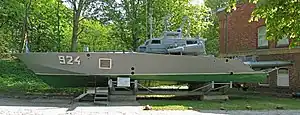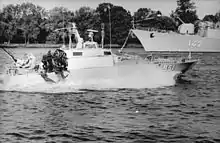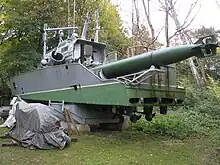 A Libelle-class boat at display | |
| Class overview | |
|---|---|
| Name | Libelle (Project 131.4) |
| Operators | |
| Built | 1974-1977 |
| In commission | 1974-1989 |
| Completed | 31 |
| Lost | 1 |
| Retired | 30 |
| Preserved | 4 |
| General characteristics | |
| Type | Torpedo boat |
| Displacement | 30 tons standard, 35 tons full load |
| Length | 18.96 m |
| Beam | 4.42 m |
| Draught | 1.74 m (lower end of propeller) |
| Propulsion | 3 x shaft M-50F4 diesels 1200 hp |
| Speed | 48 knots |
| Range | 300 nm at 34 knots |
| Endurance | 750 hours |
| Crew | 5 (1 officer) |
| Sensors and processing systems | |
| Armament | |
Project 131 Libelle Torpedo boat, also known as the Libelle Klasse (German, 'Dragonfly Class'), was a class of torpedo boats designed, build and used by the German Democratic Republic during the Cold War.

Setup
The Libelle class was based on a welded metal hull, housing a fuel tank and a total of three soviet M-50F4 diesel engines, one to the rear and two to the front. The hull also contained one 533-mm torpedo tube on each side. Project 131 carried no reloads for the torpedo tubes. The boats were designed for short ranges only and were meant to operate from floating bases (projects 62 and 162), anchored close to their area of operation. Each Project 131 boat had a small compartment in the bow to accommodate the crew for some time.[1]
On the deck, there was a pilothouse with four seats and an elevated seat in the center for the helmsman. On both sides of the pilothouse, removable ejectors for sea mines could be mounted. On the aft deck, a rear facing ZU-23-2 23 mm gun was mounted for air defence. The torpedoes were ejected to the rear, but faced forward, so that they were initially following the boat's course after hitting the water.
Production and service
30 boats were built in Rechlin and equipped in the Peene-Werft between 1974 and 1977.[1]
The 30 boats were not given any names, but had the numbers 131.401 to 131.430 assigned to them. One was lost in a collision off Hiddensee in 1986, the others were retired around 1989, with four boats being preserved.[2]
References
- 1 2 Harald Fock: "Kampfschiffe. Marineschiffbau auf deutschen Werften. 1870 bis heute" Koehler, Hamburg 1995, ISBN 3-7822-0624-X p .181
- ↑ Pr. 131 on Museum Dänholm Homepage Archived 2016-09-16 at the Wayback Machine ret. 20. August 2016
Further reading
- Günther Miel (2007). Die LTS- und KTS-Boote der Volksmarine. Vorbilder und Modelle (in German). Villingen-Schwenningen: Neckar-Verlag. ISBN 978-3-7883-1138-4.
